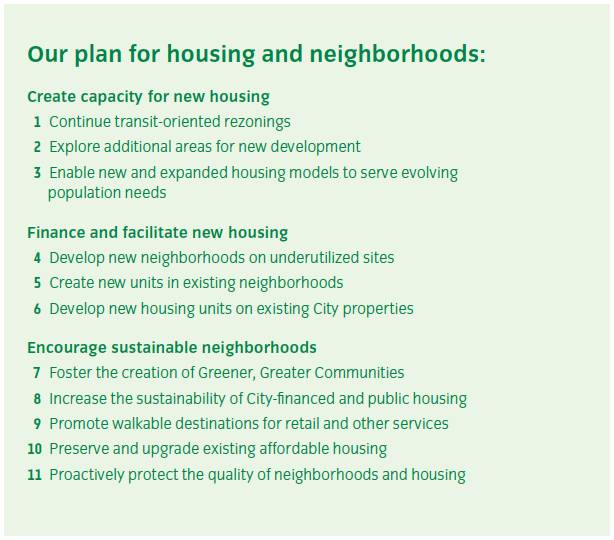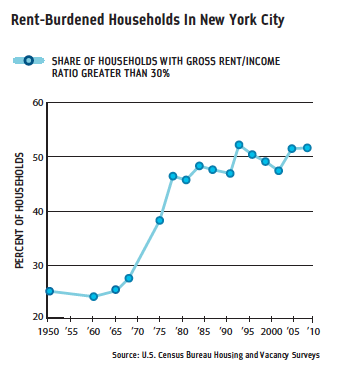This is the second section of our analysis of PlaNYC. [If you missed the Introduction, it’s right here!]

New York City is infamous for expensive apartments and the competitive, frantic search for affordable housing. Real estate is of course a very large industry here, but it is also an issue that every person living in the city confronts at some time or another. Over half of households spend more than 30% of their income on housing, and that number continues to increase. Furthermore, only 64% of all NYC apartments are affordable for median-income residents. Hence, the first major section in PlaNYC addresses concerns for Housing and Neighborhoods.
In order to maintain a successful city, people live in the city in which they work, and, ideally, use public transportation to get to their job. There need to be reasonable housing options for New Yorkers in accessible places—it is not enough to just build new apartment complexes, “we must also create and maintain sustainable, affordable neighborhoods.” In reaching this goal, however, we tread a fine line between invigorating a community and overburdening it. There are 11 different housing initiatives in this section that aim to do just that.
Initiative 1: Continue transit-oriented rezonings
Rezoning a neighborhood changes regulations about that area, such as the allowed building heights and various other incentives for developers. Developing the city in places well-served by public transportation allows the city to better prepare for growth, since places with good transit options can handle the density. For an example, the Lower Concourse in the Bronx was rezoned in 2009— a park was built, supermarkets were supported, and over 3000 units of affordable housing were renovated. The Lower Concourse was part of the Inclusionary Housing Program, which allows a residential building to be bigger if it provides low-income housing. Over 1,900 units of permanently affordable housing have been added since this program’s inception in 2005. However, large challenges still remain. Rezoning requires community and individual input so a neighborhood’s character can be preserved and grow in a way that the residents want. The city will be working with neighborhoods to ease the change.
Initiative 2: Explore additional areas for new development
Intensive research will be done by a variety of city groups and residential communities, including the New York City Housing Authority, and, especially, the MTA, in order to best determine where to build new housing. Projected endeavors include the Hudson Yards Plan, which aims to facilitate the transformation of Hudson Yards (along the west side of central Manhattan) into an extension of the thriving, vibrant Midtown district; the revitalization of the Seward Park sites, which are an underutilized area in the Lower East Side; and the consolidation of many city-owned sites that are currently used for city storage and vehicle repair.
Initiative 3: Enable new and expanded housing models to serve evolving population needs.
Housing models are currently optimized for a time of the past. A new housing model for New York would comprise of smaller housing alternatives that would better serve an aging population and changing demographics.
Initiative 4: Develop new neighborhoods on underutilized sites
This initiative encompasses the transformation of unused space and development of New York infrastructure. In the next 3 years, the city will begin construction on more than 900 housing sites, that will eventually provide 5,000 new housing units, more than half of which will be reserved for middle-income families and below.
Initiative 5: Create new units in existing neighborhoods
This initiative aims to provide a quick solution to housing using the current city framework. For example, the Melrose Commons Urban Renewal Area in the South Bronx currently has three large City-owned plots of land that will be developed into more than 700 rental units for low-income residents. These will be added to the 2,800 City-financed units that are already under construction or have been completed.
Initiative 6: Develop new housing units on existing City properties
Many New York City-owned land is not nearly being put to good use. A lot of land is used for vehicle storage and maintenance, and, let’s face it; do we really want a garbage truck auto-shop in the middle of a dense neighborhood? This initiative serves to examine specifically City-owned land, and looks at how it could be more useful, from constructing housing, to libraries and schools.
Initiative 7: Foster the creation of Greener, Greater Communities
Greener, Greater Communities is an approach that goes toward building a sustainable New York. We want our city to be more environmentally friendly and raise the quality of life for all New Yorkers. This, however, must start with small neighborhoods. There needs to be opportunities for communities and local organizations to implement their ideas and plans since, after all, the residents know their area best. Initiative 7 hopes to facilitate the improvement of bicycle paths and pedestrian areas as well as small retail and neighborhood quality.
Initiative 8: Increase the sustainability of City-financed and public housing
 Between 2005 and 2008, rents increased by 1.6% and utilities by 4.6%. There needs to be a way to manage greenhouse gas emissions and control our consumption. This initiative looks for ways to combat rising utilities and rent, and create sustainable housing solutions. It requires that all new City-financed construction projects follow Enterprise Green Communities (EGC) guidelines. This certification is specifically suited for greener, more affordable housing. This Initiative also includes the NYC Green House program, which educates residents and building owners about environmentally friendly living and ways to “go green.”
Between 2005 and 2008, rents increased by 1.6% and utilities by 4.6%. There needs to be a way to manage greenhouse gas emissions and control our consumption. This initiative looks for ways to combat rising utilities and rent, and create sustainable housing solutions. It requires that all new City-financed construction projects follow Enterprise Green Communities (EGC) guidelines. This certification is specifically suited for greener, more affordable housing. This Initiative also includes the NYC Green House program, which educates residents and building owners about environmentally friendly living and ways to “go green.”
Initiative 9: Promote walkable destinations for retail and other services
Also in line with the other neighborhood improvement initiatives, this one supports local shopping areas that will attract private investment, residents, and tourism. This initiative sponsors the creation of a “local retail zoning ‘toolkit’” in which zoning tools address neighborhood-specific retail issues. For example, this will encourage the development of a healthy supermarket or healthy bodegas in a neighborhood that doesn’t have access to good food choices. The Healthy Bodegas initiative is encompassed here, and it has so far issues more than 500 new permits to vendors who sell fresh fruit and vegetables in neighborhoods lacking healthy options. The FRESH program has also been launched, which provides zoning and financing incentives for grocery stores to move to certain neighborhoods.
Initiative 10: Preserve and upgrade existing affordable housing
As original rent-controlled housing regulations expire, many building owners are opting to renovate to market price housing instead of continuing to provide housing for moderate- and low-income residents. Here, the City is committed to working with building owners to maintain incentives for providing affordable housing, and ensuring that New Yorkers of all incomes have a place to stay. The Small Owner Repair Program couples 10-year forgivable loans with maintenance agreements that guarantee economic feasibility, physical condition, and affordability of buildings within the program. This will allow the preservation of 34,000 units through 2014.
Initiative 11: Proactively protect the quality of neighborhoods and housing
Until recently, the City relied mainly on 311, the non-emergency reporting system, to catalogue buildings in need of repair. Now, community groups, the City Council, and other state agencies will consolidate their data from a variety of sources so repairs can be made quickly and more efficiently. In the next three years, the city plans to evaluate over 1,000 at-risk buildings.
In conclusion, long term planning for housing is well underway. Development will continue along accessible routes, and affordable housing will be preserved and available. The City is committed to fostering community growth on the way toward a sustainable, green city.
